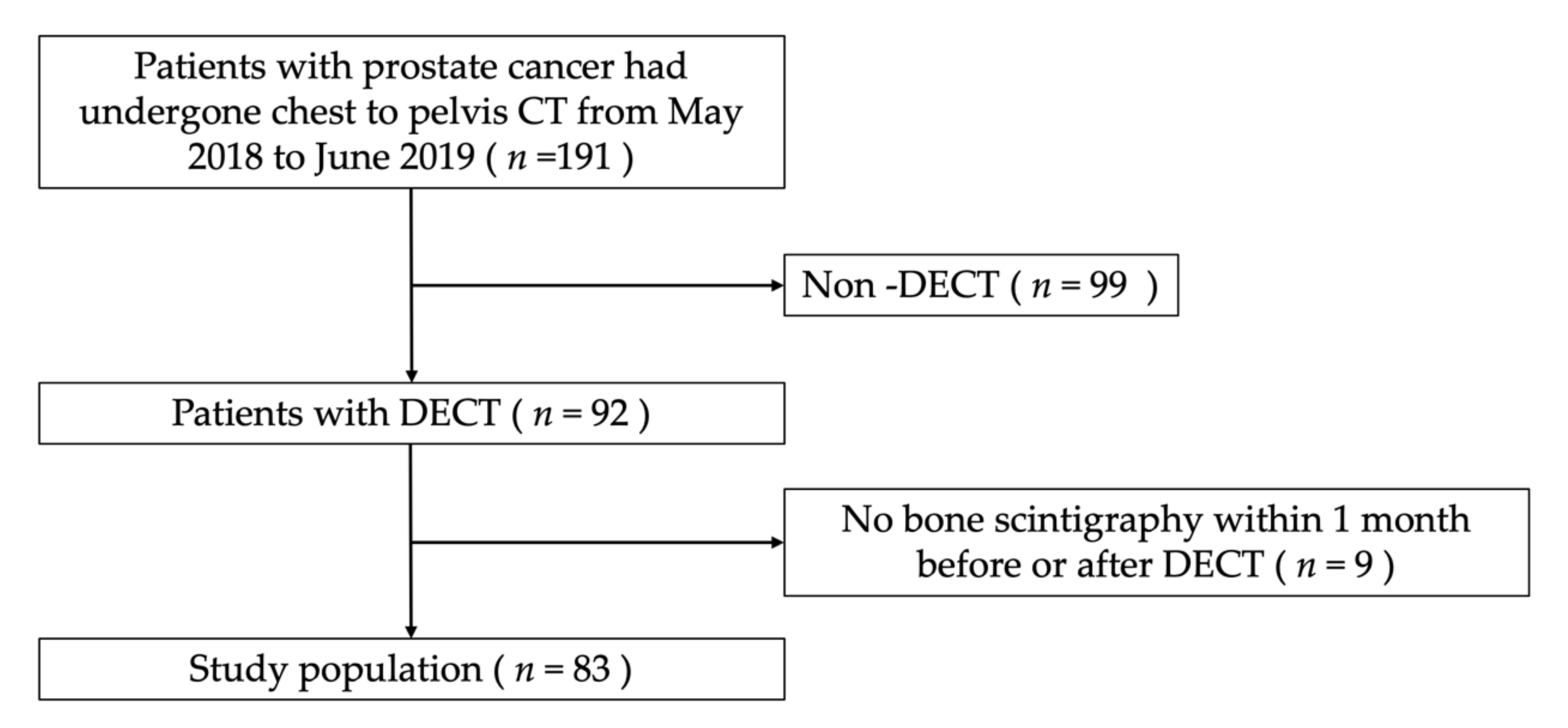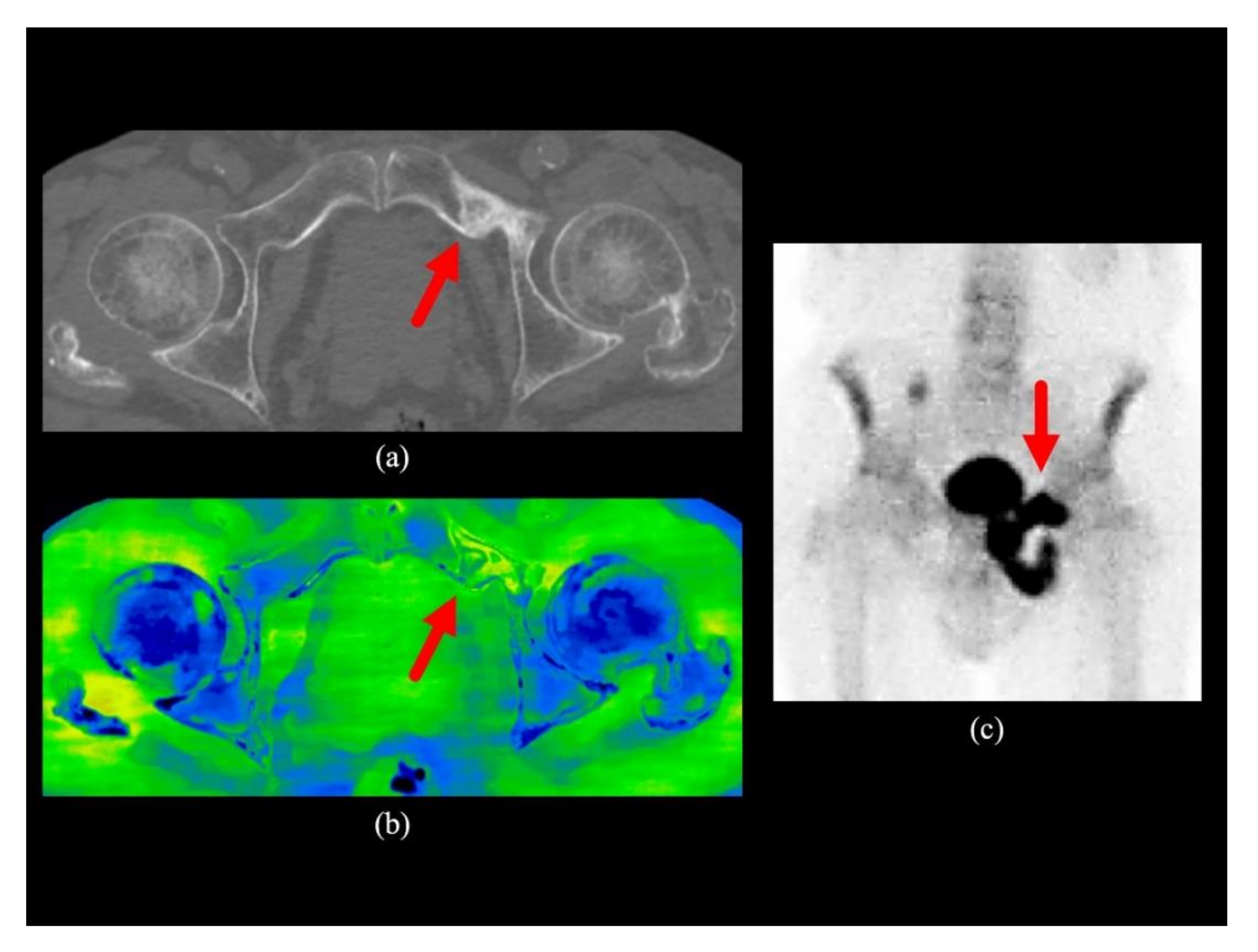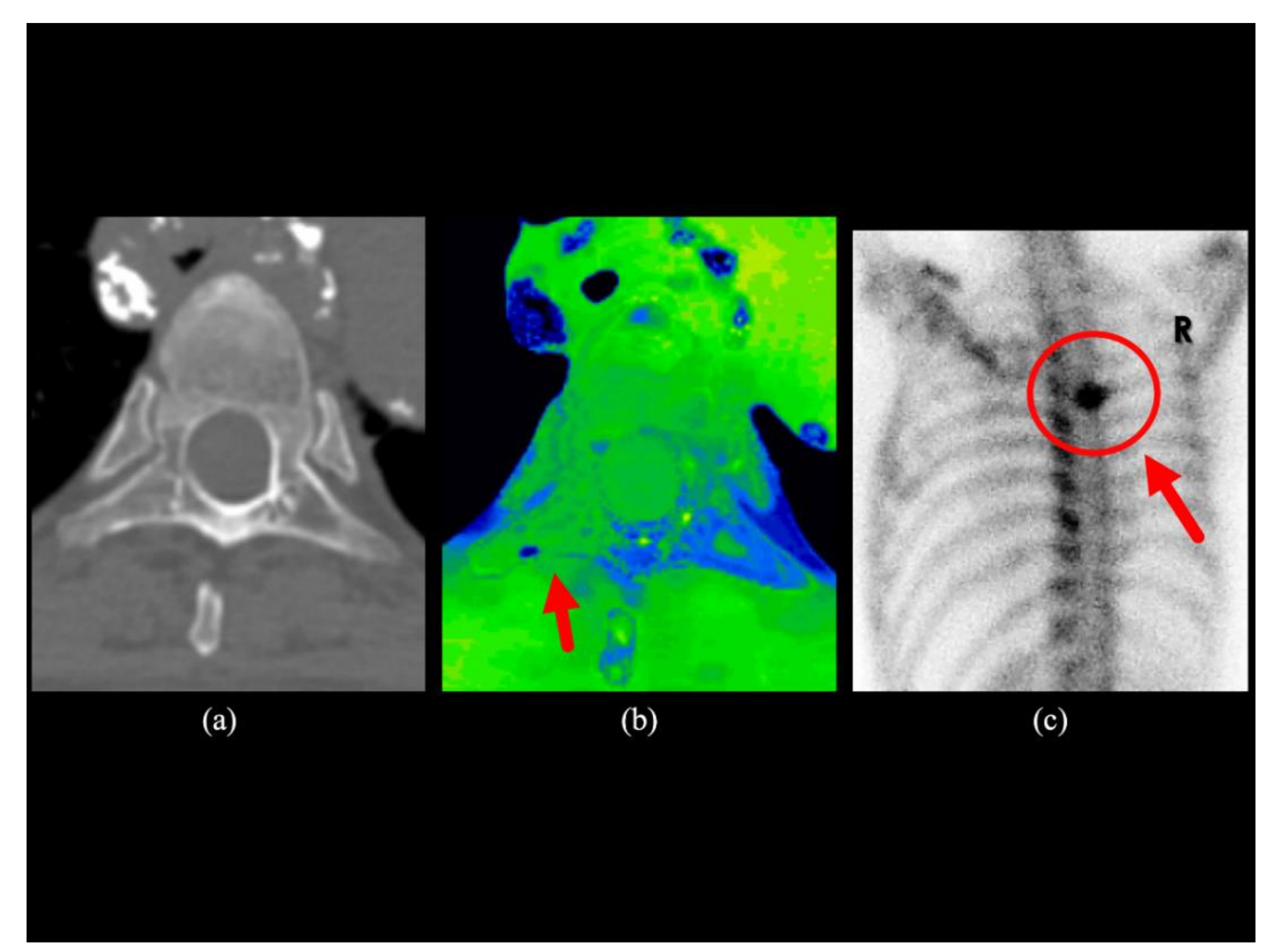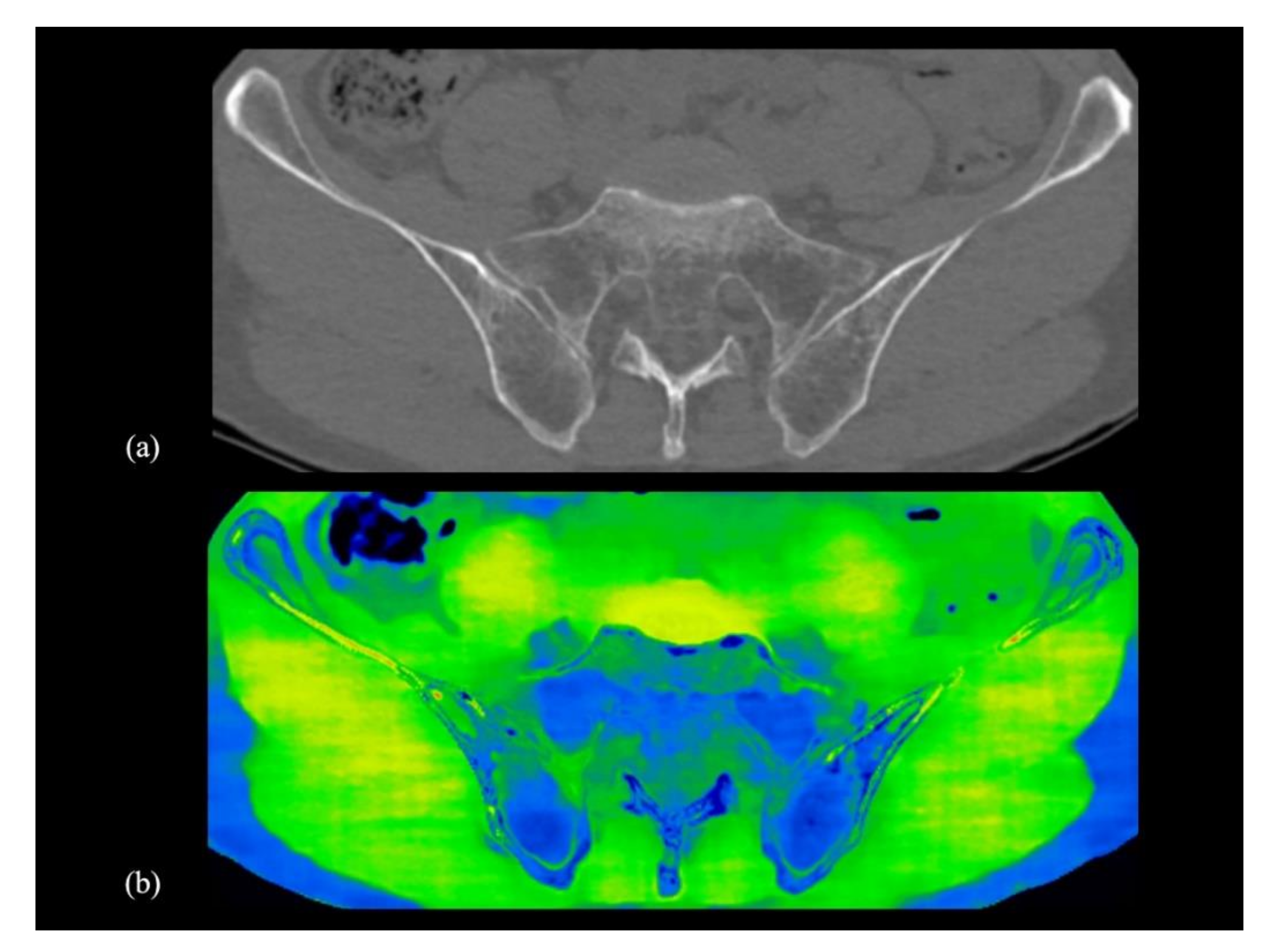Improved Diagnostic Accuracy of Bone Metastasis Detection by Water-HAP Associated to Non-Contrast CT
Abstract
1. Introduction
2. Materials and Methods
2.1. Patient Population
2.2. Data Acquisition
2.3. Data Analysis
2.4. Statistical Analysis
3. Results
4. Discussion
5. Conclusions
Author Contributions
Funding
Acknowledgments
Conflicts of Interest
Abbreviations
| AUC | Area under the curve |
| CI | Confidence interval |
| CT | Computed tomography |
| DECT | Dual-energy computed tomography |
| HAP | Hydroxyapatite |
| MRI | Magnetic resonance imaging |
| NPV | Negative predictive value |
| PPV | Positive predictive value |
| ROC | Receiver operating characteristic |
References
- Gdowski, A.S.; Ranjan, A.; Vishwanatha, J.K. Current concepts in bone metastasis, contemporary therapeutic strategies and ongoing clinical trials. J. Exp. Clin. Cancer Res. 2017, 36, 108. [Google Scholar] [CrossRef]
- Al-Muqbel, K.M. Bone Marrow Metastasis Is an Early Stage of Bone Metastasis in Breast Cancer Detected Clinically by F18-FDG-PET/CT Imaging. BioMed Res. Int. 2017, 2017, 9852632. [Google Scholar] [CrossRef]
- Yamaguchi, T.; Tamai, K.; Yamato, M.; Honma, K.; Ueda, Y.; Saotome, K. Intertrabecular pattern of tumors metastatic to bone. Cancer 1996, 78, 1388–1394. [Google Scholar] [CrossRef]
- Suzuki, A.; Kashiwagi, N.; Doi, H.; Ishii, K.; Doi, K.; Kitano, M.; Kozuka, T.; Hyodo, T.; Tsurusaki, M.; Yagyu, Y.; et al. Patterns of bone metastases from head and neck squamous cell carcinoma. Auris Nasus Larynx 2020, 47, 262–267. [Google Scholar] [CrossRef] [PubMed]
- Ahmed, F.; Muzaffar, R.; Fernandes, H.; Tu, Y.; Albalooshi, B.; Osman, M.M. Skeletal Metastasis as Detected by 18F-FDG PET with Negative CT of the PET/CT: Frequency and Impact on Cancer Staging and/or Management. Front. Oncol. 2016, 6, 208. [Google Scholar] [CrossRef]
- Palmedo, H.; Marx, C.; Ebert, A.; Kreft, B.; Ko, Y.; Türler, A.; Vorreuther, R.; Göhring, U.; Schild, H.H.; Gerhardt, T.; et al. Whole-body SPECT/CT for bone scintigraphy: Diagnostic value and effect on patient management in oncological patients. Eur. J. Nucl. Med. Mol. Imaging 2013, 41, 59–67. [Google Scholar] [CrossRef]
- Son, W.; Park, C.; Jeong, H.S.; Song, Y.S.; Lee, I.S. Bone marrow edema in non-traumatic hip: High accuracy of dual-energy CT with water-hydroxyapatite decomposition imaging. Eur. Radiol. 2019, 30, 2191–2198. [Google Scholar] [CrossRef]
- Huang, H.-C.; Srinivasan, R.; Sun, Y.; Kazakia, G.J.; Lin, P.-C.; Yeh, B.M. Detection of Lumbar Spine Osseous Metastases Using Dual-Energy CT: Phantom Results and Preliminary Clinical Validation. Am. J. Roentgenol. 2019, 212, 402–410. [Google Scholar] [CrossRef]
- Woo, S.; Suh, C.H.; Kim, S.Y.; Cho, J.Y.; Kim, S.H. Diagnostic Performance of Magnetic Resonance Imaging for the Detection of Bone Metastasis in Prostate Cancer: A Systematic Review and Meta-analysis. Eur. Urol. 2018, 73, 81–91. [Google Scholar] [CrossRef]
- Matsumoto, K.; Jinzaki, M.; Tanami, Y.; Ueno, A.; Yamada, M.; Kuribayashi, S. Virtual Monochromatic Spectral Imaging with Fast Kilovoltage Switching: Improved Image Quality as Compared with That Obtained with Conventional 120-kVp CT. Radiology 2011, 259, 257–262. [Google Scholar] [CrossRef]
- Kanda, Y. Investigation of the freely available easy-to-use software ‘EZR’ for medical statistics. Bone Marrow Transplant. 2012, 48, 452–458. [Google Scholar] [CrossRef]
- Glazebrook, K.N.; Guimarães, L.S.; Murthy, N.S.; Black, D.F.; Bongartz, T.; Manek, N.J.; Leng, S.; Fletcher, J.G.; McColloughb, C.H. Identification of Intraarticular and Periarticular Uric Acid Crystals with Dual-Energy CT: Initial Evaluation. Radiology 2011, 261, 516–524. [Google Scholar] [CrossRef]
- Glazebrook, K.N.; Brewerton, L.J.; Leng, S.; Carter, R.E.; Rhee, P.C.; Murthy, N.S.; Howe, B.M.; Ringler, M.D.; Dahm, D.L.; Stuart, M.J.; et al. Case–control study to estimate the performance of dual-energy computed tomography for anterior cruciate ligament tears in patients with history of knee trauma. Skelet. Radiol. 2013, 43, 297–305. [Google Scholar] [CrossRef]
- Nicolaou, S.; Liang, T.; Murphy, D.T.; Korzan, J.R.; Ouellette, H.; Munk, P. Dual-Energy CT: A Promising New Technique for Assessment of the Musculoskeletal System. Am. J. Roentgenol. 2012, 199, S78–S86. [Google Scholar] [CrossRef]
- Deng, K.; Zhang, C.-Q.; Li, W.; Wang, J.-J.; Wang, X.-Y.; Pang, T.; Wang, G.-L.; Liu, C. Preliminary Application of High-Definition CT Gemstone Spectral Imaging in Hand and Foot Tendons. Korean J. Radiol. 2012, 13, 743–751. [Google Scholar] [CrossRef]
- Coupal, T.M.; Mallinson, P.I.; McLaughlin, P.; Nicolaou, S.; Munk, P.L.; Ouellette, H. Peering through the glare: Using dual-energy CT to overcome the problem of metal artefacts in bone radiology. Skelet. Radiol. 2014, 43, 567–575. [Google Scholar] [CrossRef] [PubMed]
- Reddy, T.; McLaughlin, P.D.; Mallinson, P.I.; Reagan, A.C.; Munk, P.L.; Nicolaou, S.; Ouellette, H.A. Detection of occult, undisplaced hip fractures with a dual-energy CT algorithm targeted to detection of bone marrow edema. Emerg. Radiol. 2014, 22, 25–29. [Google Scholar] [CrossRef]
- Teixeira, P.A.G.; Gervaise, A.; Louis, M.; Lecocq, S.; Raymond, A.; Aptel, S.; Blum, A. Musculoskeletal wide detector CT: Principles, techniques and applications in clinical practice and research. Eur. J. Radiol. 2015, 84, 892–900. [Google Scholar] [CrossRef]
- Sun, X.; Shao, X.; Chen, H. The value of energy spectral CT in the differential diagnosis between benign and malignant soft tissue masses of the musculoskeletal system. Eur. J. Radiol. 2015, 84, 1105–1108. [Google Scholar] [CrossRef]
- Mallinson, P.I.; Coupal, T.M.; McLaughlin, P.D.; Nicolaou, S.; Munk, P.L.; Ouellette, H.A. Dual-Energy CT for the Musculoskeletal System. Radiology 2016, 281, 690–707. [Google Scholar] [CrossRef]
- Burke, C.J.; Didolkar, M.M.; Barnhart, H.X.; Vinson, E.N. The use of routine non density calibrated clinical computed tomography data as a potentially useful screening tool for identifying patients with osteoporosis. Clin. Cases Miner. Bone Metab. 2016, 13, 135–140. [Google Scholar] [CrossRef] [PubMed]
- Diekhoff, T.; Hermann, K.; Pumberger, M.; Hamm, B.; Putzier, M.; Fuchs, M. Dual-energy CT virtual non-calcium technique for detection of bone marrow edema in patients with vertebral fractures: A prospective feasibility study on a single- source volume CT scanner. Eur. J. Radiol. 2017, 87, 59–65. [Google Scholar] [CrossRef]
- Hackenbroch, C.; Riesner, H.-J.; Lang, P.; Stuby, F.; Beer, M.; Friemert, B.; Palm, H.-G.; Iii, A.B. Dual Energy Computed Tomography in Musculoskeletal Imaging, with Focus on Fragility Fractures of the Pelvis. Z. Orthop. Unf. 2017, 155, 708–715. [Google Scholar] [CrossRef] [PubMed]
- Akisato, K.; Nishihara, R.; Okazaki, H.; Masuda, T.; Hironobe, A.; Ishizaki, H.; Shota, K.; Yamaguchi, H.; Funama, Y. Dual-Energy CT of Material Decomposition Analysis for Detection with Bone Marrow Edema in Patients with Vertebral Compression Fractures. Acad. Radiol. 2020, 27, 227–232. [Google Scholar] [CrossRef] [PubMed]
- Heusner, T.; Kuemmel, S.; Koeninger, A.; Hamami, M.E.; Hahn, S.; Quinsten, A.; Bockisch, A.; Forsting, M.; Lauenstein, T.; Antoch, G.; et al. Diagnostic value of diffusion-weighted magnetic resonance imaging (DWI) compared to FDG PET/CT for whole-body breast cancer staging. Eur. J. Nucl. Med. Mol. Imaging 2010, 37, 1077–1086. [Google Scholar] [CrossRef]
- Grankvist, J.; Fisker, R.; Iyer, V.; Fründ, E.; Simonsen, C.; Christensen, T.; Stenbygaard, L.; Ewertz, M.; Larsson, E.-M. MRI and PET/CT of patients with bone metastases from breast carcinoma. Eur. J. Radiol. 2012, 81, e13–e18. [Google Scholar] [CrossRef]
- Kidoh, M.; Shinoda, K.; Kitajima, M.; Isogawa, K.; Nambu, M.; Uetani, H.; Morita, K.; Nakaura, T.; Tateishi, M.; Yamashita, Y.; et al. Deep Learning Based Noise Reduction for Brain MR Imaging: Tests on Phantoms and Healthy Volunteers. Magn. Reson. Med. Sci. 2019, 19, 195–206. [Google Scholar] [CrossRef]
- Evangelista, L.; Panunzio, A.; Polverosi, R.; Ferretti, A.; Chondrogiannis, S.; Pomerri, F.; Rubello, D.; Muzzio, P.C. Early bone marrow metastasis detection: The additional value of FDG-PET/CT vs. CT imaging. Biomed. Pharmacother. 2012, 66, 448–453. [Google Scholar] [CrossRef]
- Sheikhbahaei, S.; Jones, K.M.; Werner, R.A.; Salas-Fragomeni, R.A.; Marcus, C.V.; Higuchi, T.; Rowe, S.P.; Solnes, L.B.; Javadi, M.S. 18F-NaF-PET/CT for the detection of bone metastasis in prostate cancer: A meta-analysis of diagnostic accuracy studies. Ann. Nucl. Med. 2019, 33, 351–361. [Google Scholar] [CrossRef]
- Zacho, H.D.; Jochumsen, M.R.; Langkilde, N.C.; Mortensen, J.C.; Haarmark, C.; Hendel, H.W.; Jensen, J.B.; Petersen, L.J. No Added Value of 18F-Sodium Fluoride PET/CT for the Detection of Bone Metastases in Patients with Newly Diagnosed Prostate Cancer with Normal Bone Scintigraphy. J. Nucl. Med. 2019, 60, 1713–1716. [Google Scholar] [CrossRef]
- Aslan, S.; Cetin, B.; Akinci, M.; Cetin, M.; Yucekule, N.; Cetin, A. Computed tomography in detecting bone metastases of breast carcinoma. Is it better than plain X-ray? Saudi Med. J. 2006, 27, 1326–1328. [Google Scholar] [PubMed]
- Yang, H.; Liu, T.; Wang, X.-M.; Xu, Y.; Deng, S.-M. Diagnosis of bone metastases: A meta-analysis comparing 18FDG PET, CT, MRI and bone scintigraphy. Eur. Radiol. 2011, 21, 2604–2617. [Google Scholar] [CrossRef] [PubMed]
- Fang, T.; Deng, W.; Law, M.W.-M.; Luo, L.; Zheng, L.; Guo, Y.; Chen, H.; Huang, B. Comparison of image quality and radiation exposure between conventional imaging and gemstone spectral imaging in abdominal CT examination. Br. J. Radiol. 2018, 91. [Google Scholar] [CrossRef] [PubMed]





| Score | Conventional CT Images | Conventional CT Images Plus Water-HAP Image |
|---|---|---|
| 1 | No abnormality or findings of apparent benign bone lesions on conventional CT images | No abnormality on conventional CT images and water-HAP images, and apparent benign bone lesions on conventional CT images |
| 2 | Do not qualify as score 1, 3, 4, or 5 | Do not qualify as score 1, 3, 4, or 5 on conventional CT images. Water-HAP images show a focal asymmetric density lower than skeletal muscle but higher than surrounding bone marrow, but conventional CT images do not indicate any abnormalities |
| 3 | Ill-defined solitary sclerotic or lytic lesion | Ill-defined solitary sclerosis or lytic lesion on conventional CT images, or water-HAP images show focal asymmetrical density equal to or higher than skeletal muscle, but no abnormal density was found on conventional CT images |
| 4 | Ill-defined multiple sclerotic or lytic lesions | Ill-defined multiple sclerosis or lytic lesions, or water-HAP images show focal asymmetrical density equal to or higher than skeletal muscle consistent with an ill-defined bone sclerotic or lytic lesion on conventional CT images |
| 5 | Apparent malignant bone lesions with bone destruction or extraosseous mass on conventional CT images | Apparent malignant lytic lesion or bone sclerosis with bone destruction or extraosseous mass on conventional CT images |
| Patients Characteristics | Value |
|---|---|
| Mean age ± S.D. (years) | 76.1 ± 8.7 |
| Men (n) | 83 |
| Bone metastasis (n) | |
| Positive | 31 |
| Negative | 52 |
| Score | Conventional CT Images | Conventional CT Image Plus Water-HAP Images | ||
|---|---|---|---|---|
| rater 1 | rater 2 | rater 1 | rater 2 | |
| 1 (normal or benign) | 59 (71.1 %) | 60 (72.3 %) | 51 (61.4 %) | 52 (62.7 %) |
| 2 (probably benign) | 6 (7.2 %) | 5 (6.0 %) | 3 (3.6 %) | 3 (3.6 %) |
| 3 (unclear) | 3 (3.6 %) | 5 (6.0 %) | 10 (12.0 %) | 10 (12.0 %) |
| 4 (probably malignant) | 5 (6.0 %) | 2 (2.4 %) | 9 (10.8 %) | 6 (7.2 %) |
| 5 (malignant) | 10 (12.0 %) | 11 (13.3 %) | 10 (12.0 %) | 12 (14.5 %) |
| Total | 83 (100 %) | 83 (100 %) | 83 (100 %) | 83 (100 %) |
| Rater 1 | Rater 2 | ||||||
|---|---|---|---|---|---|---|---|
| Session | Parameter | Value | 95% CI | p-Value | Value | 95% CI | p-Value |
| Conventional CT images | Sensitivity | 0.742 | 0.643–0.768 | 0.710 | 0.610–0.736 | ||
| Specificity | 0.981 | 0.922–0.997 | 0.981 | 0.921–0.997 | |||
| PPV | 0.958 | 0.830–0.992 | 0.957 | 0.822–0.992 | |||
| NPV | 0.864 | 0.812–0.878 | 0.850 | 0.798–0.864 | |||
| AUC | 0.861 | 0.781–0.942 | <0.01 | 0.845 | 0.762–0.929 | <0.01 | |
| Conventional CT images plus water-HAP images | Sensitivity | 1.000 | 0.931–1.000 | 1.000 | 0.941–1.000 | ||
| Specificity | 0.981 | 0.940–0.981 | 1.000 | 0.965–1.000 | |||
| PPV | 0.969 | 0.902–0.969 | 1.000 | 0.941–1.000 | |||
| NPV | 1.000 | 0.958–1.000 | 1.000 | 0.965–1.000 | |||
| AUC | 0.990 | 0.972–1.000 | <0.01 | 1.000 | 1.000–1.000 | <0.01 | |
| continuous NRI | 0.867 | 0.614–1.119 | <0.01 | 0.867 | 0.614–1.119 | <0.01 | |
| IDI | 0.742 | 0.376–1.108 | <0.01 | 0.806 | 0.423–1.190 | <0.01 | |
Publisher’s Note: MDPI stays neutral with regard to jurisdictional claims in published maps and institutional affiliations. |
© 2020 by the authors. Licensee MDPI, Basel, Switzerland. This article is an open access article distributed under the terms and conditions of the Creative Commons Attribution (CC BY) license (http://creativecommons.org/licenses/by/4.0/).
Share and Cite
Ishiwata, Y.; Hieda, Y.; Kaki, S.; Aso, S.; Horie, K.; Kobayashi, Y.; Nakamura, M.; Yamada, K.; Yamashiro, T.; Utsunomiya, D. Improved Diagnostic Accuracy of Bone Metastasis Detection by Water-HAP Associated to Non-Contrast CT. Diagnostics 2020, 10, 853. https://doi.org/10.3390/diagnostics10100853
Ishiwata Y, Hieda Y, Kaki S, Aso S, Horie K, Kobayashi Y, Nakamura M, Yamada K, Yamashiro T, Utsunomiya D. Improved Diagnostic Accuracy of Bone Metastasis Detection by Water-HAP Associated to Non-Contrast CT. Diagnostics. 2020; 10(10):853. https://doi.org/10.3390/diagnostics10100853
Chicago/Turabian StyleIshiwata, Yoshinobu, Yojiro Hieda, Soichiro Kaki, Shinjiro Aso, Keiichi Horie, Yusuke Kobayashi, Motoki Nakamura, Kazuhiko Yamada, Tsuneo Yamashiro, and Daisuke Utsunomiya. 2020. "Improved Diagnostic Accuracy of Bone Metastasis Detection by Water-HAP Associated to Non-Contrast CT" Diagnostics 10, no. 10: 853. https://doi.org/10.3390/diagnostics10100853
APA StyleIshiwata, Y., Hieda, Y., Kaki, S., Aso, S., Horie, K., Kobayashi, Y., Nakamura, M., Yamada, K., Yamashiro, T., & Utsunomiya, D. (2020). Improved Diagnostic Accuracy of Bone Metastasis Detection by Water-HAP Associated to Non-Contrast CT. Diagnostics, 10(10), 853. https://doi.org/10.3390/diagnostics10100853





